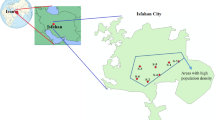Abstract
In India, the industry is gaining more attention from the public, and thus the correlation between factories and nearby pollution sources has done a subject of research. Industrialization and urbanization are increasingly expanding to make India a developed country. The outcome of modern automation contains more droplets, gas molecules, and solid particles that can lead to medical issues when inhaled. This research focuses on a comparative analysis of two machine learning algorithms to predict PM2.5 concentration monitored in an industrial area. The random forest and Naïve Bayes classifiers have been compared to predict the class of PM2.5 concentration monitored in the industrial area of Haridwar City (SIDCUL). Research shows that the Naïve Bayes classifier is best with an accuracy of 97.37% to predict the class of PM2.5 pollutants. The study shows that the concentration of PM2.5 is low in winter compared with other seasons. This prediction model of PM2.5 concentration will be proven helpful for scientists and researchers, and information about PM2.5 concentration for this industrial area will also become important for the government.
Access this chapter
Tax calculation will be finalised at checkout
Purchases are for personal use only
Similar content being viewed by others
References
Torkashvand J, Azarian G, Leili M, Godini K, Younesi S, Godini H (2015) Projection of environmental pollutant emissions from different final waste disposal methods based on life cycle assessment studies in Qazvin City. Avicenna J Environ Health Eng 2. https://doi.org/10.17795/ajehe-4653
Pant A, Sharma S, Joshi RC (2022) Air quality modeling for effective environmental management in Uttarakhand, India: a comparison of logistic regression and naive bayes. J Air Pollut Health 7:287–298. https://doi.org/10.18502/japh.v7i3.10542
Manisalidis I, Stavropoulou E, Stavropoulos A, Bezirtzoglou E (2020) Environmental and health impacts of air pollution: a review. Front Public Health 8:1–13. https://doi.org/10.3389/fpubh.2020.00014
Thongrod T, Lim A, Ingviya T, Owusu BY (2022) Prediction of PM2.5 and PM10 in Chiang Mai Province: a comparison of machine learning models. In: 37TH International technical conference on circuits/systems, computers and communications (ITC-CSCC 2022), pp 337–340. https://doi.org/10.1109/itc-cscc55581.2022.9894884
Barthwal A, Acharya D (2021) An IoT based sensing system for modeling and forecasting urban air quality. Wireless Pers Commun 116:3503–3526. https://doi.org/10.1007/s11277-020-07862-6
Bhagat J, Saha G (2021) Pollutant PM2.5 multi step prediction under seasonal influences across 13 Indian Cities. In: 2021 Innovations in power and advanced computing technologies (i-PACT), pp 1–8. https://doi.org/10.1109/i-pact52855.2021.9696866
Pal S, Pramanik D, Jain E (2021) Effectiveness of machine learning algorithms in forecasting AQI. In: IEEE Xplore, pp 492–495, https://doi.org/10.1109/ICTAI53825.2021.9673385
Singh R, Singh V, Sharma N (2019) US air quality index forecasting: a comparative study. Data Sci Anal 91–102. https://doi.org/10.1007/978-981-15-5827-6_8
Xu Y, Zhao X, Chen Y (2022) Short-term PM2.5 prediction based on a data-driven heuristic approach. In: 3rd International conference on electronic communication and artificial intelligence (IWECAI). Zhuhai, China, pp 534–539. https://doi.org/10.1109/iwecai55315.2022.00109
Yang P, Hsieh MC, Lin G-M, Chen M-J, Yeh C-H, Huang Z, Yang C-M (2018) Prediction of outpatient visits for upper respiratory tract infections by machine learning of PM2.5 and PM10 levels in Taiwan. In: International conference on consumer electronics-Taiwan (ICCE-TW). Taichung, Taiwan, pp 1–2. https://doi.org/10.1109/icce-china.2018.8448613
Pant A, Sharma S, Bansal M, Narang M (2022) Comparative analysis of supervised machine learning techniques for AQI prediction. In: International conference on advanced computing technologies and applications (ICACTA). Coimbatore, India, pp 1–4 (2022). https://doi.org/10.1109/icacta54488.2022.9753636
Chen Y, Yang S, Wang G (2021) Prediction of PM2.5 concentration in Guangzhou based on LSTM neural network. In: 2021 2nd International conference on intelligent computing and human-computer interaction (ICHCI). Shenyang, China, pp 8–12. https://doi.org/10.1109/ichci54629.2021.00009
Zhang Z, Ma X, Yan K (2021) A deep learning model for PM2.5 concentration prediction. In: 2021 IEEE international conference on dependable, autonomic and secure computing, intl conf on pervasive intelligence and computing, international conference on cloud and big data computing, international conference on cyber science and technology congress (DASC/PiCom/CBDCom/CyberSciTech). AB, Canada, pp 428–433. https://doi.org/10.1109/dasc-picom-cbdcom-cyberscitech52372.2021.00078
Yarragunta SK, Nabi MA, Jeyanthi P, Revathy S (2021) Prediction of air pollutants using supervised machine learning. In: 2021 5th international conference on intelligent computing and control systems (ICICCS). Madurai, India, pp 1633–1640. https://doi.org/10.1109/iciccs51141.2021.9432078
Ameer S, Shah MA, Khan A, Song H, Maple C, Islam SU, Asghar MN (2019) Comparative analysis of machine learning techniques for predicting air quality in smart cities. In: IEEE access, pp 128325–128338. https://doi.org/10.1109/ACCESS.2019.2925082
Li X, Li Y, Ma Q, Wang S (2021) Random forest model for PM2.5 concentration in china using Himawari-8 Hourly AOD product. In: 2021 IEEE international geoscience and remote sensing symposium IGARSS. Brussels, Belgium, pp 1935–1938. https://doi.org/10.1109/igarss47720.2021.9554364
Bhalgat P (2019) Air quality prediction using machine learning algorithms. Int J Comput Appl Technol Res 8:367–370. https://doi.org/10.7753/ijcatr0809.1006
Kumar K, Pande BP (2022) Air pollution prediction with machine learning: a case study of Indian cities. Int J Environ Sci Technol 20:5333–5348. https://doi.org/10.1007/s13762-022-04241-5
Yang P, Hsieh MC, Lin G-M, Chen M-J, Yeh C-H, Huang Z, Yang C-M (2018) Prediction of outpatient visits for upper respiratory tract infections by machine learning of PM2.5 and PM10 levels in Taiwan. In: 2018 IEEE international conference on consumer electronics-Taiwan (ICCE-TW). Taichung, Taiwan, pp 1–2. https://doi.org/10.1109/icce-china.2018.8448613
Author information
Authors and Affiliations
Corresponding author
Editor information
Editors and Affiliations
Rights and permissions
Copyright information
© 2024 The Author(s), under exclusive license to Springer Nature Singapore Pte Ltd.
About this paper
Cite this paper
Pant, A., Pant, K., Pathak, N., Ram, M. (2024). Prediction of Particulate Matter (PM2.5) for Industrial Area Based on Naive Bayes Classifier. In: Swaroop, A., Polkowski, Z., Correia, S.D., Virdee, B. (eds) Proceedings of Data Analytics and Management. ICDAM 2023. Lecture Notes in Networks and Systems, vol 786. Springer, Singapore. https://doi.org/10.1007/978-981-99-6547-2_15
Download citation
DOI: https://doi.org/10.1007/978-981-99-6547-2_15
Published:
Publisher Name: Springer, Singapore
Print ISBN: 978-981-99-6546-5
Online ISBN: 978-981-99-6547-2
eBook Packages: Intelligent Technologies and RoboticsIntelligent Technologies and Robotics (R0)




